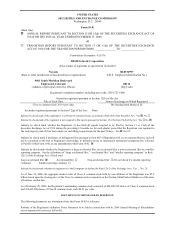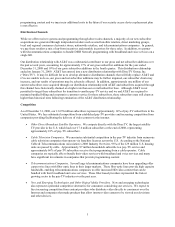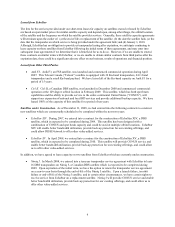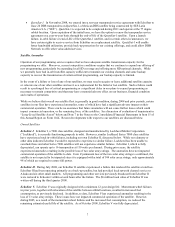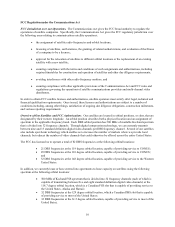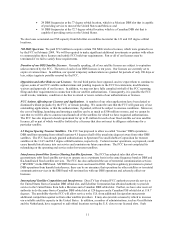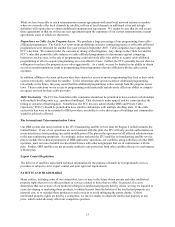Dish Network 2008 Annual Report Download - page 13
Download and view the complete annual report
Please find page 13 of the 2008 Dish Network annual report below. You can navigate through the pages in the report by either clicking on the pages listed below, or by using the keyword search tool below to find specific information within the annual report.3
programming content and we may incur additional costs in the future if our security access device replacement plan
is not effective.
Distribution Channels
While we offer receiver systems and programming through direct sales channels, a majority of our new subscriber
acquisitions are generated through independent retailers such as small satellite retailers, direct marketing groups,
local and regional consumer electronics stores, nationwide retailers, and telecommunications companies. In general,
we pay these retailers a mix of up-front incentives and monthly incentives for these sales. In addition, we partner
with telecommunications companies to bundle DISH Network programming with broadband and voice services on a
single bill.
Our distribution relationship with AT&T was a substantial contributor to our gross and net subscriber additions over
the past several years, accounting for approximately 17% of our gross subscriber additions for the year ended
December 31, 2008 and 19% of our gross subscriber additions in the fourth quarter. This distribution relationship
ended on January 31, 2009. AT&T has entered into a new distribution relationship with DirecTV Group, Inc.
(“DirecTV”). It may be difficult for us to develop alternative distribution channels that will fully replace AT&T and
if we are unable to do so, our gross and net subscriber additions may be further impaired, our subscriber churn may
increase, and our results of operations may be adversely affected. In addition, approximately one million of our
current subscribers were acquired through our distribution relationship with AT&T and subscribers acquired through
this channel have historically churned at a higher rate than our overall subscriber base. Although AT&T is not
permitted to target these subscribers for transition to another pay-TV service and we and AT&T are required to
maintain bundled billing and cooperative customer service for these subscribers, these subscribers may still churn at
higher than historical rates following termination of the AT&T distribution relationship.
Competition
As of December 31, 2008, our 13.678 million subscribers represent approximately 14% of pay-TV subscribers in the
United States. We face substantial competition from established pay-TV providers and increasing competition from
companies providing/facilitating the delivery of video content via the internet.
x Other Direct Broadcast Satellite Operators. We compete directly with the DirecTV, the largest satellite
TV provider in the U.S. which had over 17.6 million subscribers at the end of 2008, representing
approximately 18% of pay-TV subscribers.
x Cable Television Companies. We encounter substantial competition in the pay-TV industry from numerous
cable television companies that operate via franchise licenses across the U.S. According to the National
Cable & Telecommunications Association’s 2008 Industry Overview, 96% of the 129 million U.S. housing
units are passed by cable. Approximately 97 million households subscribe to a pay-TV service and
approximately 66% of pay-TV subscribers receive their programming from a cable operator. Cable
companies are typically able to bundle their video services with broadband and voice services and many
have significant investments in companies that provide programming content.
x Telecommunications Companies. Several large telecommunications companies have been upgrading older
copper wire lines with fiber optic lines in their larger markets. These fiber optic lines provide high capacity
bandwidth, enabling telecommunications companies to offer increased HD video content that can be
bundled with their broadband and voice services. These fiber-based providers represented the fastest
growing sector in the pay-TV industry over the past year.
x New and Emerging Technologies and Other Digital Media Providers. New and emerging technologies
also represent a potential competitive alternative for consumers considering our services. We expect to
face increasing competition from content providers who distribute video directly to consumers over the
Internet and companies that make products that allow internet video content to be viewed on televisions
and other devices.




